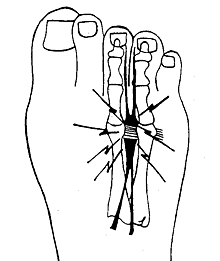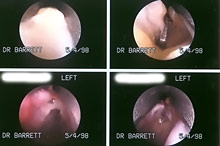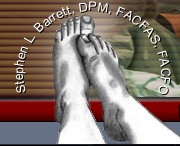| Neuromas
 A
neuroma is an entrapment of a small nerve in the foot. Symptoms may
include pain, numbness, and/or burning sensations in the ball of the
foot which may radiate out into the toes or up the leg. Pain occurs
while standing or walking and can range from mild to severe. It may
be worsened by wearing tight-fitting or high heeled shoegear and may
be relieved by removing the shoes and massaging the affected area. A
neuroma is an entrapment of a small nerve in the foot. Symptoms may
include pain, numbness, and/or burning sensations in the ball of the
foot which may radiate out into the toes or up the leg. Pain occurs
while standing or walking and can range from mild to severe. It may
be worsened by wearing tight-fitting or high heeled shoegear and may
be relieved by removing the shoes and massaging the affected area.
What Causes It?
It is usually related to instability
in the mechanical function of the foot. This instability results in
the nerve being compressed against or pulled across a rigid,
unyielding ligament called the transverse intermetatarsal ligament.
It is this repetitive microtrauma to the nerve that causes it to
become inflamed and eventually entrapped in scar tissue. If allowed
to persist over long periods of time, this process and its resulting
symptoms may become irreversible causing considerable disability.
What can be done?
Once the symptoms are recognized,
proper medical care should be obtained as soon as possible to
minimize the possibility of permanent nerve damage. This potentially
debilitating condition requires the skills of a specialized
practitioner to properly diagnose, counsel, and successfully treat
the patient in order to restore normal foot function. The goal of
treatment is to allow the individual to maintain or return to a
normal lifestyle.
How is it treated?
A number of conservative,
non-surgical treatment options may be utilized. Oral
anti-inflammatory medications and/or injections may alleviate pain.
However, the cause of the problem must be addressed. Biomechanical
control of the foot and the elimination of microtrauma on the nerve
is of paramount importance in order to insure lasting relief of
symptoms. If conservative treatment fails to relieve the symptoms,
then surgery may be required.
Endoscopic Decompression: A New Surgical Technique
 Endoscopic
decompression of intermetatarsal nerve is a new surgical technique
developed by Endoscopic Foot Specialists to permanently correct
neuroma pain in a less traumatic manner. Endoscopic
decompression of intermetatarsal nerve is a new surgical technique
developed by Endoscopic Foot Specialists to permanently correct
neuroma pain in a less traumatic manner.
This technique allows for a quicker
recovery and a faster return to normal activity than traditional
surgical techniques. Specially designed instrumentation is utilized
that allows the surgeon to directly visualize the foot structures on
a video screen through three small, less than ¼ inch incisions on
the foot. The procedure is performed in an outpatient setting.
Most patients can bear weight immediately after surgery and return
to tennis shoes the day after surgery. Everyone heals differently.
Factors such as age, weight, circulation, and occupation contribute
to healing times.
|



